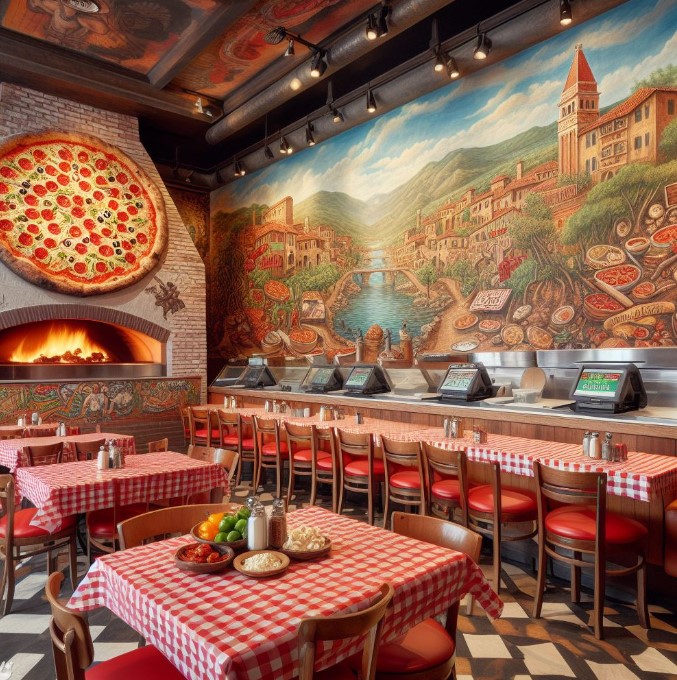Opening a pizza restaurant in the UK can be an exciting venture, but it requires careful planning and consideration of various factors. Here's a guide to help you navigate the key aspects:
- Local Demand: Analysing the local demand is a crucial step in establishing a successful pizza restaurant. Dive into the demographics of the area where you intend to open your establishment. Consider factors such as age groups, income levels, and cultural preferences. Conduct surveys or focus groups to gather insights directly from the potential customer base. Understanding not only the appetite for pizza but also specific preferences, such as preferred toppings or dining habits, will enable you to tailor your menu to meet the unique tastes of the community. Additionally, take note of any seasonal variations in demand, as this can influence menu planning and marketing strategies.
-
Competition: A comprehensive understanding of the competitive landscape is paramount to positioning your pizza restaurant effectively. Identify and evaluate existing pizza establishments in the vicinity. Beyond merely listing competitors, delve into a detailed analysis of their strengths and weaknesses. Consider factors such as menu variety, pricing strategies, customer service, and overall brand image. This assessment will not only help you identify potential gaps in the market but also guide the development of your Unique Selling Proposition (USP). Your USP is what sets your pizza restaurant apart and gives customers a compelling reason to choose your establishment over others. It could be a unique flavour profile, a signature cooking technique, or an innovative dining experience. By leveraging your USP, you can carve out a distinct identity in the local pizza scene and attract a loyal customer base.
Business Plan

Developing a robust business plan is the foundation for a successful pizza restaurant venture. A well-crafted plan will serve as a roadmap, guiding your decisions and actions as you navigate the intricacies of the industry. Here are key components to include:
-
Concept: Clearly define your restaurant's concept. Outline the type of pizza you will offer, whether it's traditional Italian, gourmet, or a unique fusion. Consider other offerings such as appetisers, desserts, or beverages that complement your pizza theme.
- Target Audience: Identify your target audience and tailor your offerings to meet their preferences. Consider factors such as age, income, and lifestyle. Understanding your audience will influence not only your menu but also your marketing strategies.
- Marketing Strategy: Detail your marketing plan to attract and retain customers. This should encompass both online and offline strategies. Include plans for social media engagement, local partnerships, promotions, and any special events. Consider how you'll differentiate your restaurant in a crowded market.
- Financial Projections: Provide a detailed financial forecast covering at least the first three to five years. This should include projected revenue, expenses, and profit margins. Use historical data if available and make realistic assumptions about growth rates. Break down your projections by month or quarter for a more granular understanding.
- Startup Costs: Enumerate all the costs associated with starting your pizza restaurant. This includes expenses such as leasing a location, purchasing equipment, licensing fees, interior design, and initial marketing efforts. Be thorough to avoid underestimating the capital required.
- Operating Expenses: Outline your ongoing operating expenses. This includes rent, utilities, staff wages, ingredient costs, marketing, and any other recurring costs. Categorise these expenses to facilitate budget tracking and management.
- Break-Even Analysis: Conduct a break-even analysis to determine when your business will become profitable. Identify the point at which your revenue equals your expenses, providing a clear benchmark for financial sustainability. This analysis is crucial for understanding the time it will take to recoup your initial investment.
Remember, a well-prepared business plan not only attracts potential investors but also serves as a dynamic document that can be revised and updated as your pizza restaurant grows and evolves. It's a valuable tool for strategic decision-making and ensuring the long-term success of your business.
Selecting good location
Selecting a strategic location with high foot traffic and visibility is paramount for the success of your pizza restaurant. The right location serves as the gateway to attracting potential customers and establishing a strong presence in the community. Aim for areas with a vibrant and diverse demographic, ensuring your restaurant appeals to a broad range of tastes. High foot traffic guarantees a steady stream of potential patrons, increasing the likelihood of turning passersby into loyal customers. Visibility, both physical and digital, is equally crucial. Choose a location with a prominent storefront and ample signage, making it easy for people to notice and remember your restaurant. Additionally, consider the online visibility of the location—whether it's easily searchable on maps and social media platforms. A strategic location sets the stage for your pizza restaurant to become a local hotspot, creating a welcoming and accessible space for pizza enthusiasts to indulge in your culinary creations.
Licensing and Regulations

Prior to opening your pizza restaurant, it is imperative to thoroughly familiarise yourself with the local health and safety regulations, food hygiene standards, and licensing requirements.
In the United Kingdom, the operation of a food establishment, including a pizza restaurant, is subject to various regulations and standards to ensure food safety and public health. Here are some key regulations that businesses in the food industry typically need to comply with:
- Food Safety Act 1990: This legislation outlines the general requirements for food safety in the UK. It covers issues such as food handling, labelling, and the sale of unsafe food.
- Food Hygiene Regulations (various): Regulations such as the Food Hygiene (England) Regulations 2006 and equivalent regulations in other parts of the UK set out specific hygiene requirements for food businesses. They cover areas like cleanliness, training, and temperature control.
- Food Standards Act 1999: This legislation establishes the Food Standards Agency (FSA) and provides a framework for food standards and food safety.
- HACCP (Hazard Analysis and Critical Control Points): HACCP is an internationally recognized system for reducing the risk of safety hazards in food. Many food businesses, including restaurants, implement HACCP principles to identify and control potential hazards.
- Licensing Act 2003: If your pizza restaurant serves alcohol, you'll need to comply with the Licensing Act. This includes obtaining the appropriate licences for the sale of alcohol on the premises.
- Environmental Health and Local Authority Regulations: Local authorities play a significant role in regulating and inspecting food businesses. Environmental health officers ensure that establishments comply with food safety and hygiene standards.
- Allergen Information: Under the Food Information Regulations 2014, food businesses must provide clear information about allergenic ingredients in the food they serve. This is crucial for customers with food allergies.
- Waste Management Regulations: Proper disposal of waste, including food waste, is regulated to prevent environmental pollution. Businesses are expected to have appropriate waste management practices in place.
It's essential to check with the local environmental health department and relevant authorities for specific requirements in the area where your pizza restaurant is located. Regulations may vary between different regions within the UK, and staying informed and compliant is key to operating a successful and lawful food business.
Crucial elements

- Menu Development: Craft a diverse and appealing menu with a variety of pizza options. Consider accommodating dietary preferences such as vegetarian, vegan, or gluten-free choices.
- Quality Ingredients: Source high-quality ingredients for your pizzas. Fresh and local produce can enhance the taste and appeal of your offerings.
- Suppliers: Establish relationships with reliable suppliers for your pizza ingredients. Negotiate bulk pricing and ensure consistent quality.
- Interior Design and Ambiance: Create a welcoming and comfortable atmosphere. The interior design should reflect your brand and appeal to your target audience.
- Staffing: Recruit experienced kitchen staff who are skilled in pizza preparation. Hire friendly and customer-oriented front-of-house staff.
- Marketing: Develop a strong online presence through a user-friendly website and active social media profiles. Consider promotions, loyalty programs, and partnerships to attract customers.
Embarking on the journey of opening a pizza restaurant in the UK requires careful planning and consideration of various factors. This comprehensive guide covers essential steps, from conducting thorough market research and developing a unique selling proposition to selecting a strategic location with high visibility. It emphasizes the importance of compliance with local health and safety regulations, food hygiene standards, and licensing requirements. Additionally, the guide delves into the significance of a well-crafted business plan, detailing concepts, target audiences, marketing strategies, and financial projections. By following these key steps, aspiring entrepreneurs can set the stage for a successful and sustainable pizza venture in the UK.
next


